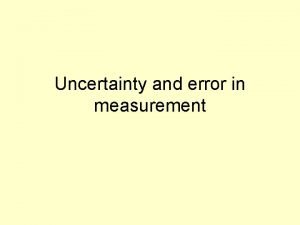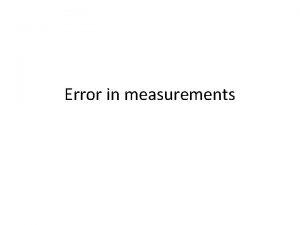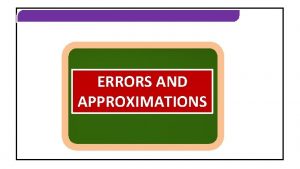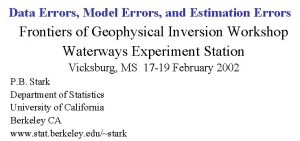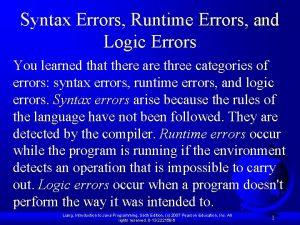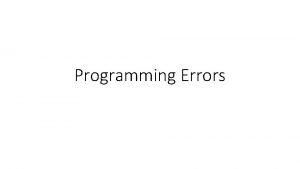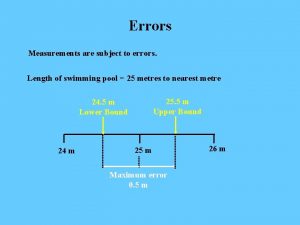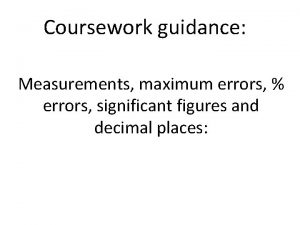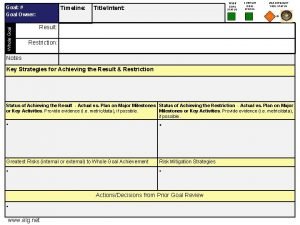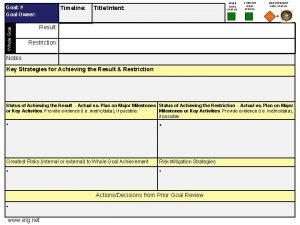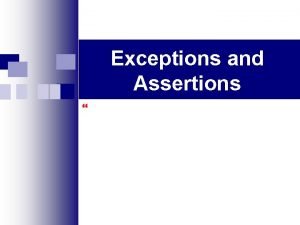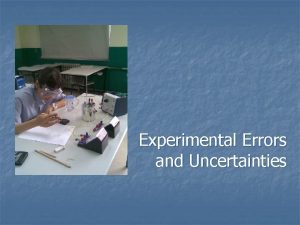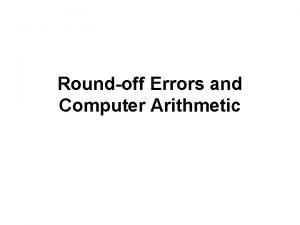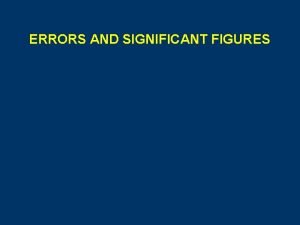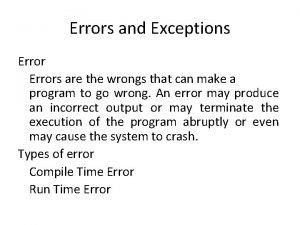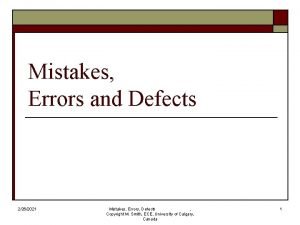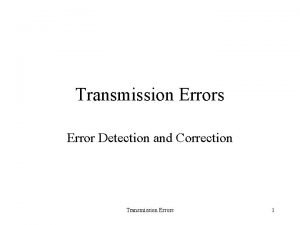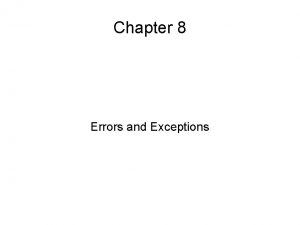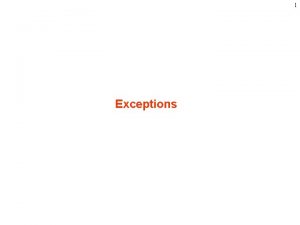Measurements Measurements and errors Here the goal is



























- Slides: 27

Measurements • Measurements and errors : - Here , the goal is to have some understanding of the operation and behavior of electrical test instruments. Also , to gain practical information on their use.

• Instruments : is a device for determining the value or magnitude of a quantity or a variable. 1) Accuracy : is a measure of how close the output reading of an instrument is to the correct value. Note : In practice , it’s more usual to express it by inaccuracy which is the extent to which a reading might be wrong ( uncertainty ).

• Example : a voltmeter with a voltage range of ( 0 -10 V ) with uncertainty of ± 1 % of the full scale (f. s) reading. - Notice that when measuring 10 V (f. s) we obtain a reading of 9. 9 and when measuring 1 V we obtain a reading of 1. 1 V which had an inaccuracy of 10% in the other hand for the 10 V just 1%. - Hence , it is very important that instruments are chosen such that their range is appropriate to the value being measured.

• 2) precision : it is a measure of the reproducibility of the reading that describes an instrument’s degree of agreement within a group of readings. This means that if a large numbers of reading are taken of the same quality by a high precision instrument , then the spread of readings will be very small.

• Note : High precision does not imply anything about measurement accuracy , ( a high precision instrument may have a low accuracy ). - The reproducibility describes the closeness of the output readings for the same input when there are changes in the method of measurement , observer , measuring instrument , location , conditions of use and time of measurement. - The reproducibility in measurements from an instrument is one way of expressing it’s precision.

- Example :

• 3) Sensitivity : it is the ratio of the output signal ( or response ) of the instrument to a change of input. • 4) Resolution : is the lowest limit on the magnitude of the change in the input measured quantity that produces an observable change in the instrument output.

• Example : A car speedometer , the subdivisions are typically 20 km/h this means that when the needle is between the scale markings , we cannot estimate speed more accurately than to the nearest 5 km/h and this is the meter resolution.

5) Error : is the deviation from the true value of the measured variable. - Note : precision is composed by two things : - 1 - conformity ( necessary , but not a sufficient condition for precision (lack of significant figures ). 2 - significant figures. - Precision is a necessary , but not sufficient for accuracy.

• Significant figures : - None zero integers : they always count as significant figures. - Zeros : (a) Leading zeros : They never count as significant figures. Example : 0. 0025 2 S. F 0. 00250 3 S. F

(b) captive zeros : They always count as S. F. Example : 1. 008 4 S. F (c) Trailing zeros : These zeros are S. F only if the number contains a decimal point. Example : 100 1 S. F 100. 0 4 S. F 100. 3 S. F 1. 00 X 1020 3 S. F

- Note : The expression ( 1. 00 X 102 ) has some advantages : 1) The number of significant figures can be easily indicated. 2) Fewer zeros are needed to write a very large/small numbers.

• Applications : - Multiplication / Division : Here , the number of S. F. in the result is the same as the number in the least precise measurement used in the calculation. Example : 4. 56 X 1. 4 least S. F ____ 6. 384 6. 4

- Subtraction / Addition : Here , the result has the same number of decimal places as the least precise measurement. Example : 12. 11 +18. 0 1 decimal 1. 013 ______ 31. 123 31. 1

• One way in getting close to the true value is taking several measurements and then obtaining their arithmetic mean ( average ). The range of possible error is known as the largest deviation from the mean. Example : we have obtained the following voltage measurement : ( 117. 02 V , 117. 11 V , 117. 08 V , 117. 03 V ) Find : 1) Average voltage. 2) Range of error.

Answer : Vavg = ∑ V = 117. 06 ______ 4 Error range = Vmax - Vavg = 0. 05 = VH = Vavg – Vmin = 0. 04 = VL Error range = ( VH + VL ) = ± 0. 045 ___________ 2

• Range of doubt : (RD) (1) Addition : X 1 = 826 ± 5 X= X 1 + X 2 = 1454 ± 8 X 2 = 628 ± 3 8 X 100% = 0. 55 % _________ 1454 X 1+X 2 ± (a 1+a 2) Rd = ( (a 1+a 2) / ( x 1+x 2) ) X 100%

(2) Subtraction : same X 1 , X 2 X = X 1 -X 2 = 198 ± 8 8 X 100% = 4. 04 % X 1 -X 2 ± (a 1+a 2) Rd = ( (a 1+a 2) / ( x 1+x 2) ) X 100% _________ 198 - Here , we see that the percentage doubt differs greatly after subtraction compared to addition. • This tells us that you should avoid measurement techniques that depends on subtraction of results.

(3) Multiplication : • Example : X 1= 8. 62 ± 0. 02 X 2= 12. 34 ± 0. 04

* Division EX : X 1=10. 1 ± 0. 1 X 2=5. 3 ± 0. 2 X=X 1/X 2=? Steps : 1) Divide the numerator (added to it the (+Rd) ) by the denominator ( added to it the (-Rd) ) to get the worst answer. 10. 2 / 5. 1 = 2. 0 (X 1+a 1) / ( X 2 - a 2 ) = R 2) Perform the division using the original number. 10. 1 /5. 3 = 1. 9 X 1/X 2 = D 3) Obtain the difference between 1 and 2. 2. 0 – 1. 9 = 0. 1 R-D 4) X= X 1/X 2 = 1. 9 ± 0. 1 D ± ( R-D) OR X 1/X 2 ± (R-D)

• Types of errors : In measurements , Errors may come from different sources : 1) Gross error : This error comes from human mistakes in reading or using the instrument. Example : A voltmeter with sensitivity of 1000 Ω/V reads 100 V on its 150 V scale when connected across an unknown resistor in series with a milliameter when it reads 5 m. A. 1) Apparent resistance of the unknown. 2) The actual resistance of the unknown. 3) Error due to the loading effect of the voltmeter.

• Answer : 1) RT V=IR RT = V/I = 100/5 m. A = 20 KΩ 2) RV = 1000Ω/V X 150 V = 150 KΩ RT = ( Rx RV ) / ( Rx+ RV ) = 20 ׃. Rx= RT RV ---------------- RT – RV = 23. 05 3) Error = (actual – app ) / actual. = (23. 05 – 20 ) / 23. 05 = 13. 13 %

2) Systematic error : a) Instrumental error. b)Environmental error. a. This error is due to the instruments mechanical structures. ( i. e. calibration error ). Here , there is a need for setting the instrument at the zero reference before taking any measurement.

• Hence , in general : (1) One should select a suitable instrument. (2) Apply correction factor after determining the amount of instrument error. - One should check for erratic behavior and stability and reproducibility of result.

• b. Here, external conditions affecting the instrument (i. e. change in temperature , humidity, pressure , magnetic field … etc ). - The Instrumental error is subdivided into 2 categories : 1 - static : this error is cause by the limitation of the device. 2 - Dynamic : this error is caused by the instrument not responding fast enough to follow changes in the measured value.

• 3) Random error : Is an error that is caused by unknown causes. This error may occur even when systematic errors have been accounted for. Example : A voltmeter monitoring a voltage for half an hour , readings that vary slightly will be seen over the period of observation , the only way to offset ( overcomes) these errors is by increasing the number of readings and using the statistical mean.

• Arithmetic mean ( average ) : It represents the most probable value of a measured variable. The more readings we have, the more accurate results we get.
 Random errors may be detected by repeating the measurements
Random errors may be detected by repeating the measurements There's a place where mercy reigns
There's a place where mercy reigns Hình ảnh bộ gõ cơ thể búng tay
Hình ảnh bộ gõ cơ thể búng tay Bổ thể
Bổ thể Tỉ lệ cơ thể trẻ em
Tỉ lệ cơ thể trẻ em Gấu đi như thế nào
Gấu đi như thế nào Tư thế worms-breton
Tư thế worms-breton Hát lên người ơi alleluia
Hát lên người ơi alleluia Các môn thể thao bắt đầu bằng tiếng đua
Các môn thể thao bắt đầu bằng tiếng đua Thế nào là hệ số cao nhất
Thế nào là hệ số cao nhất Các châu lục và đại dương trên thế giới
Các châu lục và đại dương trên thế giới Cong thức tính động năng
Cong thức tính động năng Trời xanh đây là của chúng ta thể thơ
Trời xanh đây là của chúng ta thể thơ Mật thư tọa độ 5x5
Mật thư tọa độ 5x5 Phép trừ bù
Phép trừ bù Phản ứng thế ankan
Phản ứng thế ankan Các châu lục và đại dương trên thế giới
Các châu lục và đại dương trên thế giới Thể thơ truyền thống
Thể thơ truyền thống Quá trình desamine hóa có thể tạo ra
Quá trình desamine hóa có thể tạo ra Một số thể thơ truyền thống
Một số thể thơ truyền thống Cái miệng nó xinh thế
Cái miệng nó xinh thế Vẽ hình chiếu vuông góc của vật thể sau
Vẽ hình chiếu vuông góc của vật thể sau Biện pháp chống mỏi cơ
Biện pháp chống mỏi cơ đặc điểm cơ thể của người tối cổ
đặc điểm cơ thể của người tối cổ Thế nào là giọng cùng tên
Thế nào là giọng cùng tên Vẽ hình chiếu đứng bằng cạnh của vật thể
Vẽ hình chiếu đứng bằng cạnh của vật thể Vẽ hình chiếu vuông góc của vật thể sau
Vẽ hình chiếu vuông góc của vật thể sau
